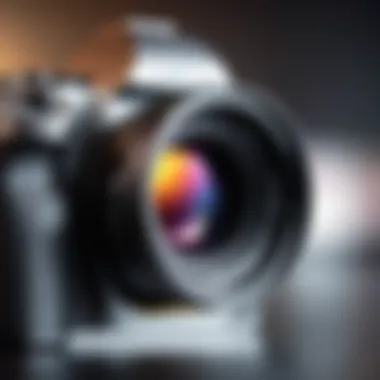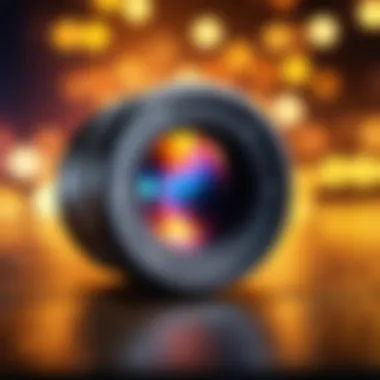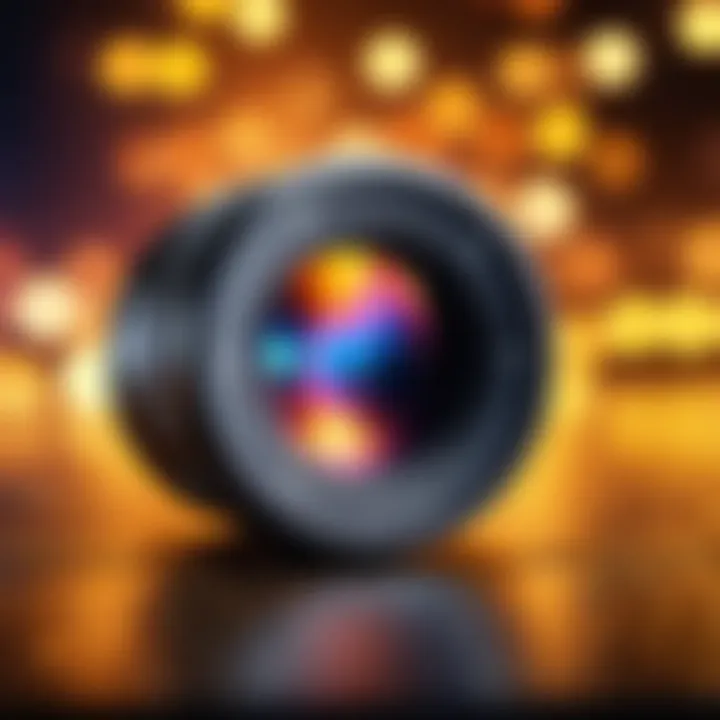Mastering the Art of Blurry Backgrounds in Photography


Intro
Creating a blurry background in photography is a coveted technique that profoundly influences the visual storytelling aspect of an image. This effect, widely known as 'bokeh,' can elevate an ordinary photograph to an artistic masterpiece. Understanding how to manipulate depth of field and employing the right equipment are crucial steps in achieving this distinct blur. In the following sections, we will delve into key features and specific methodologies that photographers, both amateur and professional, can apply.
Key Features
When aiming for a stunning bokeh effect, several features play essential roles. Among these, camera settings and lens selection are paramount. A camera equipped with a larger sensor tends to produce better bokeh. Similarly, fixed focal length lenses, like prime lenses, generally set the stage for a more pronounced effect.
- Aperture Size: Wider apertures (lower f-stop numbers) create a shallower depth of field, enhancing background blur.
- Focal Length: Longer focal lengths increase the separation between the subject and background, intensifying the effect.
- Distance to Subject: Positioning your subject closer to the camera while keeping the background farther away leads to a cleaner separation.
"Depth of field is the area of an image that appears sharp. By manipulating this, photographers can draw attention to their subject while softly blurring distracting elements behind it."
Camera Settings
Proper camera settings greatly impact the blur effect. Here are key settings to adjust:
- Aperture: Set your camera’s aperture to its widest setting (e.g., f/1.8, f/2.8).
- ISO: Maintain a low ISO for better image quality. Adjust it as necessary based on lighting conditions.
- Shutter Speed: Ensure your shutter speed is fast enough to prevent motion blur, especially in low light situations.
Lens Choices
Selecting the appropriate lens is crucial for achieving the desired bokeh. Here are some recommended lenses:
- Nikon 50mm f/1.8: A fantastic option for sharp images with a pleasing blur.
- Canon 85mm f/1.8: Great for portraits, it creates a smooth background separation.
- Sony 35mm f/1.4: Excellent for both photographs and videography with great low-light performance.
Post-Editing Techniques
After capturing the image, post-editing can help enhance the bokeh effect. Techniques include:
- Selective Blur: Use software like Adobe Photoshop or Lightroom to selectively blur areas of the image.
- Gradient Filters: Apply gradient filters to manipulate focus and blur.
- Color Adjustments: Adjusting colors may enhance how the blur appears in the resulting image.
Finale
Manipulating background sharpness in photography not only improves the aesthetic quality of images but also strengthens the narrative conveyed through visual art. Understanding and applying these techniques will enable photographers to create compelling imagery that resonates deeply with viewers. Incorporating these methods can proficiently refine the artistry of any photographer, paving the way for greater creativity and technical prowess.
Understanding Background Blur
In photography, creating a blurry background, often referred to as the bokeh effect, is a technique that many photographers aspire to master. This effect serves not just an aesthetic purpose; it isolates the subject from the backdrop, enhancing focus and adding depth to the image. Understanding how background blur works is essential for both novice and experienced photographers. It allows one to manipulate the viewer's perception and draws attention toward the primary subject. When executed properly, the bokeh effect can transform an average photo into a compelling visual narrative.
What is Background Blur?
Background blur occurs when the camera's focus is locked onto a subject, while the surrounding scene is rendered out of focus. This phenomenon is mainly influenced by depth of field, which is determined by several factors including aperture size, distance from the subject, and the type of lens used.
- Aperture dictates how much light enters the lens. A wider aperture (smaller f-number) creates a shallower depth of field, resulting in more pronounced background blur.
- Distance plays a critical role. Getting closer to the subject while maintaining a distance from background elements can amplify the blur effectively.
- Lens Type also matters. Certain lenses, like prime lenses, are conducive to achieving beautiful bokeh due to their optical designs.
Understanding these elements provides the foundation for effectively using background blur to enhance images.
The Role of Depth of Field
Depth of field is the key factor that controls how much of an image is in focus versus how much is blurred. It can be defined as the zone of acceptable sharpness within a photo. A narrow depth of field leads to a more significant separation between the subject and the background.
There are several considerations regarding depth of field:
- Aperture Setting: As mentioned, wider apertures will create a shallower depth of field. For instance, an aperture setting of f/1.8 produces noticeable background blur compared to f/8.
- Focal Length: Longer focal lengths compress the scene and create more separation between subject and background, further enhancing blur.
- Sensor Size: Cameras with larger sensors (like full-frame cameras) generally provide a shallower depth of field compared to crop sensors, influencing the amount of background blur achievable.
Understanding depth of field is pivotal for photographers. Adjusting these variables grants creative control over how background blur serves their visual narrative.
Technical Aspects of Camera Settings
Understanding the technical aspects of camera settings is crucial for achieving a desirable blurry background effect in photography. Proper manipulation of settings can significantly influence the final image, granting the photographer greater control over the artistic representation of their vision. The key to mastering this lies in three primary areas: aperture, shutter speed, and ISO settings. Each of these elements works in tandem to either enhance or detract from the bokeh effect. Recognizing their interactions can help creators produce visually stunning images that resonate with their audience.
Aperture Settings and Impact on Blur


Aperture plays a pivotal role in determining depth of field, which directly affects background blur. The aperture is the opening in a lens through which light enters the camera. It is measured in f-stops, and lower values correspond to wider openings. For instance, an aperture setting of f/1.4 allows more light in than an f-stop of f/8.
The impact on blur is substantial; wider apertures create a shallower depth of field. This means that only a small portion of the image will be in focus, pushing the background further away from clarity. As such, when aiming for that soft, dreamy bokeh, a setting of f/2.8 or wider is often recommended. Experimenting with different aperture settings will provide valuable experience and insight into how they affect image outcomes.
Shutter Speed Considerations
Shutter speed is another critical factor that influences photography outcomes. This setting controls how long the camera’s sensor is exposed to light. Faster shutter speeds can freeze motion but may not significantly impact background blur. Conversely, slower speeds increase light exposure but can introduce motion blur if not managed carefully.
When capturing images with a wide aperture, it is important to balance your shutter speed to avoid overexposing the image. A good rule of thumb is to use a shutter speed that is at least equal to the focal length of your lens. For example, if using a 50mm lens, aim for a shutter speed of at least 1/50 seconds. This ensures that the background remains soft while keeping the subject sharp.
ISO Settings for Optimal Quality
ISO refers to the sensor's sensitivity to light. A lower ISO value, such as 100 or 200, is ideal for well-lit scenarios, while higher ISO settings (800 and above) are beneficial in low-light conditions. However, increasing ISO has its own pitfalls; higher values can introduce noise, diminishing the overall quality of the image.
For the best results related to background blur, maintaining a low ISO in bright conditions is preferable. This allows the photographer to open up the aperture wider without worrying about image noise. In practice, balancing aperture, shutter speed, and ISO leads to optimal quality and enhanced bokeh effects.
Remember: The interplay of these three settings—aperture, shutter speed, and ISO—is the foundation for effective photographic techniques to achieve a blurry background. Adjust each setting based on the lighting conditions and the desired outcome to ensure a successful image capture.
By understanding and effectively using the technical aspects of camera settings, photographers can become proficient in creating images with beautiful background blur. This capability enhances not just aesthetic appeal, but also the storytelling aspect of their work.
Choosing the Right Lens
Selecting the right lens is essential in photography, especially when aiming for a blurry background, known as the bokeh effect. The choice of lens not only affects the depth of field but also determines how the subject interacts with its surroundings. A suitable lens can significantly enhance the visual appeal of your photos. Several key factors should be considered when making this decision, including aperture size, focal length, and the type of lens itself.
Prime Lenses vs. Zoom Lenses
Prime lenses and zoom lenses both have their advantages. Prime lenses typically have a larger maximum aperture, allowing for better low-light performance and a shallower depth of field. This makes them ideal for achieving that creamy background blur. For instance, a 50mm f/1.8 prime lens is popular among portrait photographers because it produces a pleasing bokeh and sharp subject focus.
On the other hand, zoom lenses offer versatility. They allow photographers to change the focal length without needing to switch lenses. However, zoom lenses usually have smaller maximum apertures, which can limit background blur. Still, some high-end zoom lenses like the Canon EF 24-70mm f/2.8L are designed to create attractive blurs while providing flexibility in framing your shot.
- When choosing between them, consider:
- Your style of photography.
- The specific shooting environments you frequent.
- Budget constraints, as prime lenses often provide high quality for a lower price compared to premium zooms.
The Importance of Focal Length
Focal length is critical in determining how background blur is achieved. Longer focal lengths tend to compress the background and provide a more pronounced blur, making the subject stand out. For example, a 200mm lens will create a significant separation from the background compared to a 35mm lens used at the same distance from the subject.
In contrast, wider frames like a 24mm lens will include more background elements, which might dilute the bokeh effect you want. Thus, the choice of focal length not only impacts the composition but also how effectively you can isolate your subject from the background.
- Key considerations for focal length:
- Determine the distance between you and the subject.
- Evaluate how much of the background you want to include.
- Understand how different focal lengths interact with aperture settings to influence depth of field.
"The right lens can be the difference between a good photo and an exceptional one, especially in mastering the art of background blur."
Subject and Background Relationship
Understanding the relationship between the subject and the background is crucial when aiming to create a blurry background effect in photography. This relationship highlights how the distance between your subject and the background can significantly affect the resulting image. When the subject is considerably closer to the camera compared to the background, a pleasing bokeh effect can be achieved. The benefits of this approach include greater emphasis on the subject and the ability to isolate it from distractions, enhancing the visual impact of the photograph.
Acknowledging this dynamic allows photographers to control narrative within their composition. The right balance ensures the viewer's focus remains on the subject, while the background adds depth without overshadowing the main focus.
Distance Between Subject and Background
To achieve optimal background blur, the distance between the subject and the background plays a pivotal role. The greater the distance between these two elements, the more pronounced the blur becomes. This effect is due to the depth of field principles. By positioning the subject far from the background, it allows for a separation that softens the details of the backdrop, creating that sought-after bokeh appearance.
This technique is especially effective in outdoor settings. For instance, in a garden, placing the subject closer to the camera and ensuring background elements such as trees or fences are positioned further away will yield a more intriguing image. A common misstep is to underestimate this distance; even slight shifts can yield vastly different results.
In practical terms, a good distance may typically range from five to ten feet. However, this varies based on your chosen lens and camera settings. Referring to online photography communities or researching specific techniques can provide insight into effective distances suitable for your subject matter.
Using Background Elements Wisely
In photography, background elements should not be an afterthought. They can either enhance or detract from your subject. Choosing backgrounds with interesting colors or textures can add layers to your composition. When selecting backgrounds, elements like shapes and patterns also matter. Look for elements that will create a contrast against the subject but remain complementary.


Some photographers favor unintrusive backgrounds, such as muted colors, which can help to isolate the subject even further. Others may integrate dynamic patterns as a way to guide the eye back to the focus of the image.
In summary, analyzing your surroundings is essential. Ensure that your background aligns with the narrative you wish to convey. Be mindful of distractions that might pull attention away from your subject. In this way, the relationship between your subject and background becomes a collaborative force, enhancing overall image effectiveness.
"The essence of impactful photography lies not only in the subject but significantly in how it relates to its surroundings."
By following these principles, photographers can greatly improve their skills in managing the subject-background relationship, leading to a stronger visual narrative.
Post-Processing Techniques
Post-processing is a vital aspect of photography that allows photographers to refine their images after they have been captured. In the context of achieving a blurry background effect, post-processing serves as a powerful tool to enhance the visual appeal of a photograph. One can correct, modify, or elevate the initial image to achieve the desired aesthetic of background blur, also known as bokeh.
- Benefits of Post-Processing
- Flexibility: Photographers can still tweak their shots post-capture, allowing modifications that can turn a seemingly ordinary photo into something breathtaking.
- Correction of Mistakes: Sometimes, initial settings do not yield the expected outcome. With post-processing, one can rectify focus issues or enhance background blur without needing to reshoot.
- Creative Control: It gives artists the freedom to express their vision, adjusting elements like color balance, brightness, and saturation while focusing on the subject's prominence against a softened background.
However, it is important to handle post-processing judiciously. Over-editing can lead to unnatural results that might distract from the photograph's essence. Keeping adjustments subtle can ensure that the photograph remains inviting and compelling.
Using Editing Software for Blur
Editing software is key for applying background blur effectively. Applications such as Adobe Photoshop, Lightroom, or more intuitive tools like Snapseed provide a range of functionalities to achieve the bokeh effect.
When utilizing any editing software, consider the following steps:
- Choose a Subject: Begin by selecting the subject you want to remain sharp in the image. This should be the focal point of your photograph.
- Apply a Mask: Use masking tools to define the area around the subject that you wish to blur. In Photoshop, the Quick Selection Tool can be effective.
- Adjust Blur Settings: Once the subject is masked, apply Gaussian Blur or Lens Blur filters to the background. Adjust the intensity based on your artistic vision.
- Refine Edges: Pay attention to the edges of your masked area. Ensure that transitions between the subject and the background are smooth to avoid harsh lines.
"Post-processing is like a painter’s brush; it has to be used to enhance, not to create the entire picture."
Selective Focus in Edits
Selective focus editing allows photographers to manipulate focus areas within an image deliberately. This paves the way for emphasizing the subject and ensuring the background is suitably blurry.
When employing selective focus in your edits:
- Utilize Filters: Specific filters can simulate depth of field effects. ClearDark or similar plugins can specifically add a notable blur to backgrounds.
- Layering Techniques: In Photoshop, create multiple layers with different opacity levels to add depth without losing essential details. This can help achieve a more natural blur.
- Experiment with Vignettes: Applying a vignette effect can draw attention toward your subject while softly blurring the edges, creating an illusion of depth.
Engaging with selective focus allows for dynamic storytelling within your images. By calling attention to key areas while downplaying others, your photographs can convey more intricate narratives.
By understanding and implementing post-processing techniques, photographers can significantly enhance their ability to create stunning blurry backgrounds, adding another layer to their artistry.
Smartphone Photography Tips
In the era of advanced technology, smartphones have become powerful tools for photography. Creating a blurry background effect, often referred to as the bokeh effect, is not solely limited to professional cameras. Smartphone users can achieve stunning results with techniques designed specifically for mobile devices. Understanding how to leverage smartphone features not only enhances photographic outcomes but also elevates the overall experience of capturing images.
Utilizing Built-in Camera Features
Modern smartphones come equipped with a variety of camera features aimed at improving photography. Many devices have built-in modes that facilitate the creation of a blurry background. For instance, portrait mode is common in many smartphones like the iPhone and Samsung Galaxy series. This feature uses software algorithms to simulate depth of field, which helps in isolating the subject from the background.
To use portrait mode effectively:
- Ensure good lighting conditions to assist the camera’s focus.
- Maintain an appropriate distance from your subject, as most portrait modes work best within certain ranges.
- Experiment with angles and position to see how the background blur changes with depth.
In addition, some smartphones allow manual control over camera settings. By adjusting exposure and focus manually, users can mimic semi-professional techniques. Utilizing the touch focus feature helps in precisely selecting the subject while achieving desirable background smudging.
Apps for Enhanced Control
While smartphone cameras offer impressive features, third-party apps can further refine creative control. Applications like Adobe Lightroom, Snapseed, and Afterlight provide extensive editing options, including ability to edit depth and blur.
With these apps, consider the following:
- Edit Depth: Some apps allow users to modify the depth effect after taking a photo. Adjusting the amount of blur applied to the background can enhance the aesthetic of your shot.
- Selective Tools: Use selective focus tools to highlight specific parts of the image while blurring others. This adds an artistic touch to photographs and helps emphasize the main subject.
- Filters and Effects: Some applications offer filters designed exclusively for enhancing the bokeh effect. These filters can add an additional layer of refinement, creating pleasing visual textures.
"Smartphone apps enable photographers to gain control over aspects that conventional photography might restrict."


Common Mistakes to Avoid
Understanding common pitfalls is essential for mastering the blurry background effect in photography. Many photographers, especially beginners, can easily overlook key elements that negatively impact their images. Recognizing these errors can significantly enhance the quality of obtained results. This section will explore two of the most common mistakes: overusing filters and neglecting composition.
Overusing Filters
Filters can add unique effects to photographs, but reliance on them for creating a blurry background often leads to artificial-looking results. When filters like Gaussian blur are applied excessively, they can distort an image, making it less appealing. The purpose of background blur is often to achieve a natural depth of field, which should complement the subject rather than overshadow it.
Here are several points to keep in mind:
- Use filters sparingly: The goal is to enhance the photo without making it look fake.
- Favor lens capabilities: Adjusting your aperture or distance is much more effective and authentic compared to heavy filtering.
- Avoid overly dramatic effects: Filters should not distract from the overall composition. A subtle approach will generally yield better results.
By minimizing filter usage, photographers can maintain a cleaner, more professional appearance in their work.
Neglecting Composition
Composition remains a critical element in photography. Many beginners focus only on achieving the right settings for background blur, while forgetting the importance of framing and visual balance. Neglecting composition can lead to cluttered and confusing images that fail to attract attention.
Here are a few considerations:
- Rule of thirds: This classic composition technique helps guide the viewer's eye towards the subject. Position your subject away from the center to add interest and depth.
- Lead the eye: Use lines and shapes within the frame to direct attention towards the main subject. Ensure the background supports this objective.
- Simplify the background: A busy background contrasts with the intended blur effect and can create distractions. Aim for a clean backdrop that enhances the subject.
Ultimately, a solid composition amplifies the effectiveness of the blurry background. The right combination of these aspects will create powerful images that resonate with viewers.
Practical Exercises to Improve Skills
Practicing photography techniques is essential for mastering background blur, or bokeh. Through practical exercises, photographers develop a deeper understanding of how different settings affect background sharpness. This exploration helps refine skills and enhances creativity, making the learning process both structured and engaging.
In these exercises, photographers can take deliberate actions to test various settings and configurations. The goal is not only to learn what works but also to recognize how these choices impact the final image. Also, experimenting can lead to discovering a unique style.
Experimenting with Different Settings
Experimenting with different camera settings is crucial for anyone aiming to create effective background blur. Start by adjusting the aperture. A larger aperture, like f/1.8 or f/2.8, significantly reduces depth of field, resulting in richer bokeh. In contrast, smaller apertures increase sharpness throughout the image.
Additionally, try changing the distance between the subject and background. A good distance can enhance the blur effect. For instance, when taking a portrait, positioning the subject further away from the background can fruitfully create layers.
Also, take note of shutter speed and ISO settings. While these may not directly influence blur, their interaction with aperture can impact overall image quality.
Make a list of settings you wish to try:
- Aperture values (f-stops)
- Subject-background distance
- Different focal lengths using lenses
By observing how these settings alter the image outcome, photographers will improve their skillset and understanding of this artistic aspect.
Comparative Studies in Blurry Tips
Another useful exercise involves comparative studies of your results. After capturing images with different settings, review them side by side. Analyze what worked and what did not. This practice sharpens observational skills and encourages a critical mindset.
Consider the following questions while comparing:
- Which aperture created the most pleasing background blur?
- How did the distance from subject to background affect the overall composition?
- Are there specific focal lengths that resulted in a softer bokeh?
Use tools such as photo editing software to inspect images at a pixel level. This will enhance your awareness of clarity versus blur. You may want to share your findings on forums such as reddit.com or photography groups on facebook.com for feedback.
The End
In summary, the importance of effectively mastering background blur techniques in photography cannot be underestimated. This article has dissected the various facets of achieving the elusive bokeh effect that elevates an image. Understanding how background blur interacts with subject focus can significantly enhance visual storytelling. Moreover, the techniques discussed expand the photographer's toolkit, allowing for a more creative approach in different scenarios, whether one is shooting portraits, landscapes, or still life.
Recap of Techniques Discussed
Throughout this article, we have explored several key methods and considerations for creating a blurry background in photography:
- Understanding Background Blur: We delved into what background blur is and how depth of field plays a critical role in achieving this effect.
- Technical Camera Settings: The importance of aperture, shutter speed, and ISO was examined. Each setting directly influences the outcome of the blur.
- Choosing the Right Lens: We compared prime lenses and zoom lenses, emphasizing the significance of focal length.
- Subject and Background Relationship: Key strategies included adjusting the distance between the subject and background and using background elements wisely to enhance the visual impact.
- Post-Processing Techniques: We looked at how editing software can help refine the blur effect and how selective focus can be used post-capture.
- Smartphone Photography Tips: We discussed utilizing built-in camera features and apps that enhance control over the blur effect, which is particularly relevant in today’s mobile-first photography environment.
- Common Mistakes to Avoid: Identifying pitfalls like overusing filters and neglecting composition can save time and improve overall results.
- Practical Exercises to Improve Skills: Engaging in exercises to apply different techniques and conduct comparative studies enables the photographer to refine their skills.
Encouragement for Further Exploration
Photographers are encouraged to continue exploring the various methods available for creating a blurry background. Practical application of the techniques discussed can lead to improved skills and unique artistic expressions. Experimentation is key; therefore, finding new environments or subjects can inspire creativity and lead to unexpected results. You may also wish to examine online forums like reddit.com and platforms like facebook.com to share your experiences and learn from others.
Continue pushing the boundaries of your abilities, and don’t hesitate to adjust settings or try out new lenses for varied outcomes. Every capture holds the potential for something remarkable, and understanding the concept of background blur is just one of many steps towards mastering photography.

